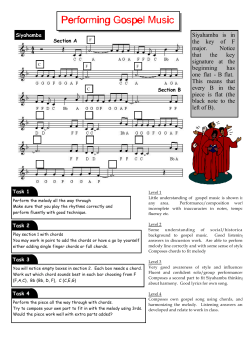
Chord Root Relationships Harmonic Progressions/ Harmonic Rhythm Progressive Root Motion
Harmonic Progressions/ Harmonic Rhythm Chord Root Relationships Dr. Peter Wood University of South Alabama Progressive Root Motion Descending 5th = Ascending 4th (strongest, known as “circle progressions”) IV Major Keys: iii I ii I-vi, ii-viio, iii-I, IV-ii, V-iii, vi-IV, viio-V i-VI, iio-viio, III-I, iv-iio, V-III, VI-iv, viio-V I-vi-IV-ii-viio-V I-ii-iii-IV-V-vi-viio i-iio-III-iv-V-VI-viio A few commonly used exceptions vi-V, VI-V IV-I, iv-I viiº vi V iv Ascending 2nd I-IV, ii-V, iii-vi, IV-viio, V-I, vi-ii, viio-iii i-iv, iio-V, III-VI, iv-viio, V-I, VI-iio, viio-III I-IV-viio-iii-vi-ii-V-I Descending 3rd Chord Progression Minor Keys: VII III viiº VI i iiº V 1 Progressive Root Motion Progressive Root Motion In major keys I can go to anything. ii can go to viiº or V. iii can go to vi or IV. IV can go to ii, viiº, V, or I. V can go to I or vi. vi can go to IV, ii, or V. viiº can go to V or I. In minor keys i can go to anything. iiº can go to viiº or V. III can go to VI or iv. iv can go to iiº, viiº, V, or i. V can go to VI or i. VI can go to iv, iiº, or V. viiº can go to V or i. VII can go to III. Some Trivia Harmonization of a Melody Repeated chords are not considered “progressive” or “retrogressive.” The cadential 6/4 chord (I64) does not function as a I chord. Instead, it is considered a decoration and extension of the V chord that follows it: Two types of melodies Chorale/hymn tunes Folk tunes One chord for each note of the melody Slower harmonic rhythms, often one chord per measure (I64-V)-I = V-I 2 To Harmonize a Chorale Tune Determine all possible chords for each melody note. Choose the cadence chords: usually half (?-V) or authentic (V-I) cadences. Select chords that form: 1. 2. 3. 1. 2. 3. 4. 5. Progressive root motion (desc 5th, desc 3rd, asc 2nd) Preferably circle progressions (desc 5th) Choose repeated chords sparingly, and change inversion when you do. Write out the bass line, and consider using first-inversion chords to create smoother bass melodies. Fill in inner voices of chorale. To Harmonize a Folk Tune Choose a harmonic rhythm. 1. 1. 2. Determine all possible chords for each section of melody. 2. 1. 2. Eliminate notes that appear to be non-harmonic tones. Try to use all notes involved in leaps. Choose cadence chords. 3. 1. Most often half and authentic cadences Select chords. 4. 1. 2. 5. Usually change chords on each downbeat. Often change chords in the middle of the measure in duple and quadruple meters and on beat 3 in triple meters. Create progressive root motion. Preferably circle progressions Write accompaniment. 3
© Copyright 2025





















